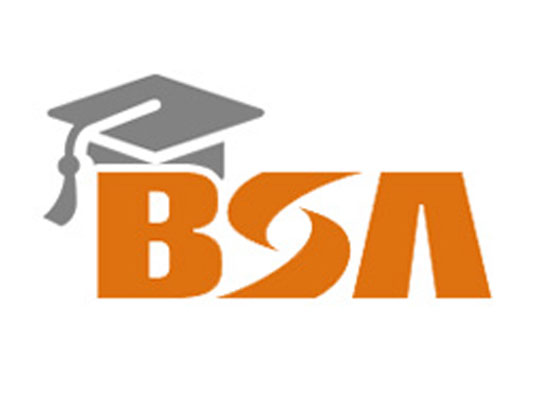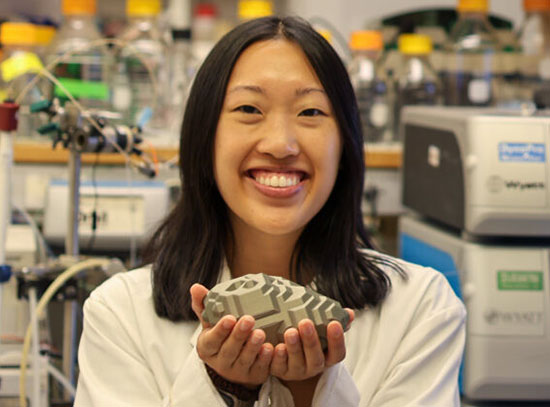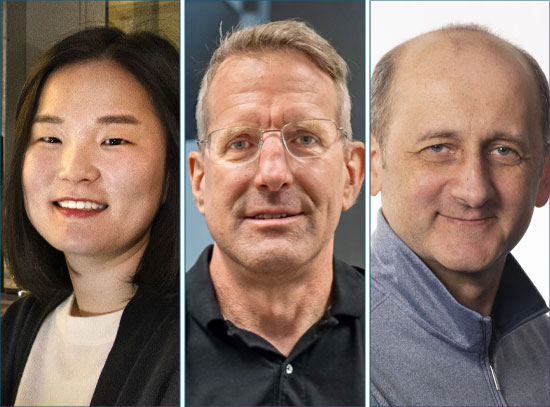Meet NSLS-II's Lisa Miller
May 1, 2019
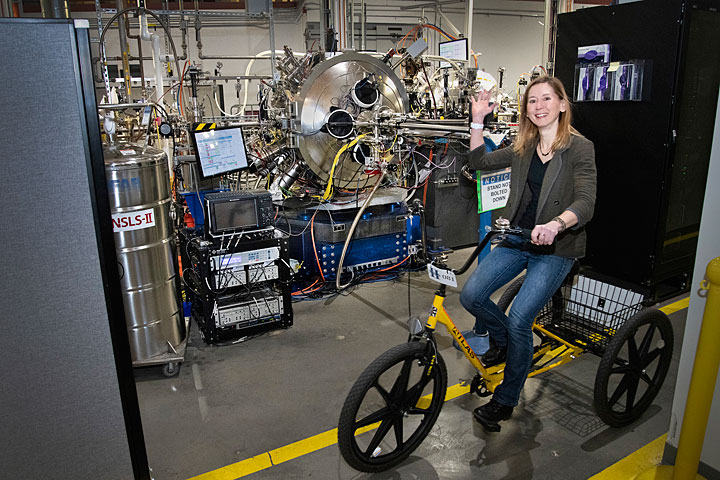 enlarge
enlarge
As the manager of NSLS-II's USCEO office, Lisa Miller can usually be found traveling around the facility's experimental floor on trike—the most fun (and the safest) way to quickly get around NSLS-II's half-mile ring.
When Lisa Miller isn’t managing outreach efforts at the National Synchrotron Light Source II (NSLS-II), she’s using the facility’s ultrabright x-ray light to study neurological protein-misfolding diseases, such as Alzheimer’s disease.
Today, Miller is the manager of NSLS-II’s user services, communications, education, and outreach (USCEO) office, but she first came to the U.S. Department of Energy’s (DOE) Brookhaven National Laboratory 25 years ago as a doctoral student at NSLS, the predecessor of NSLS-II—a DOE Office of Science User Facility at Brookhaven.
“My thesis advisor came to NSLS all the time,” Miller said. “He would send a team of four students and we would spend a lot of time collecting each other’s data. I always got the night shift.”
Having developed a passion for scientific collaboration and helping others collect their data, Miller decided to come back to NSLS for a postdoctoral research project—building an infrared beamline (experimental station) for biological research.
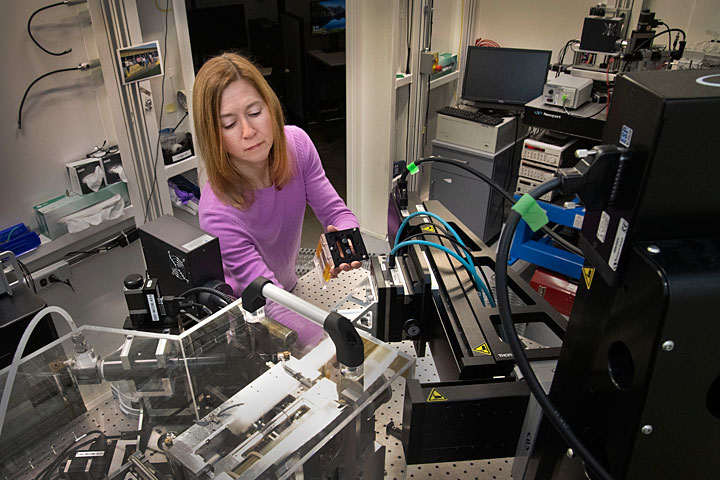 enlarge
enlarge
When Lisa Miller isn't managing outreach efforts at NSLS-II, she's using the facility's ultrabright x-ray light to study neurological protein-misfolding diseases, such as Alzheimer's disease.
“And I’ve been here ever since,” she said. “After my postdoc, I ran two infrared beamlines at NSLS for 15 years.”
Growing up, Miller and her three younger sisters were always encouraged to follow whatever career path they wanted. “Being a girl didn’t matter,” she said. “My dad taught us to drive a tractor, change the oil in the car, and fix the leaky sink. We got tools for our birthdays.”
Of the four girls, Miller was the only one to become a scientist. “I always knew I liked science, but I never imagined working at a synchrotron light source,” she said. “I wanted to get a faculty job in a four-year undergraduate institution and teach. Research was a secondary thing to me. But in my early years at NSLS, I had such supportive mentors. All of the beamline scientists were so willing to help me succeed that, after a year, I had no desire to look for a faculty position.”
During her time at NSLS and NSLS-II, Miller has been researching “protein-misfolding” diseases like Alzheimer’s disease, in which normal proteins in the brain clump together to form “plaques” and cause neurodegeneration—the death of brain cells.
“We used the x-ray and infrared microscopes at NSLS to show that these plaques are loaded with metal ions like copper and zinc,” Miller said. “These metals are nutritionally essential, but they’re not supposed to be in the plaques. We’ve hypothesized that the metals can cause toxic reactions in the brain, leading to cell death. Now we are trying to figure out how and why this happens.”
To move the field forward, Miller is developing new research methods that use the advanced capabilities of NSLS-II.
“NSLS-II is a huge improvement for my research, especially in terms of the spatial resolution it provides,” she said. “Now we have these really tiny x-ray beams that enable us to image individual parts of the cells, including cell membranes, in order to understand how the metal ions are transported into the cells and damage them. The suite of imaging beamlines that we have here at NSLS-II enables us to study the problem from the level of the brain tissue all the way down to individual molecules in the cells.”
Throughout her years of research, Miller retained her interest in science education. In 2001, she was asked to lead NSLS’s information and outreach office. Then, once NSLS-II was established, she became the facility’s first manager of USCEO.
“Continuing my research is a really important part of my career, but that includes sharing my passion for science through teaching and outreach,” she said. As an adjunct associate professor in chemistry and biomedical engineering at Stony Brook University, Miller mentors doctoral students in synchrotron science. “Their generation will figure out the next cool things that synchrotrons can do.”
Miller’s outreach efforts extend to the visiting researcher, or “user,” program that she oversees at NSLS-II.
“My goal is for the users at NSLS-II to have a “Disneyland” user experience—to be able to do top-notch research, from conceiving the idea to doing the experiments and publishing the work, and having us support that. It’s more than just the photons; it’s everything from the registration process to comfortable accommodations and good coffee.”
From the visiting researchers to the beamline scientists and support staff, Miller says having the chance to interact with so many different people is her favorite part of working at the light source.
“We have a tremendous variety of personalities and a melting pot of people from all over the world,” she said. “The synchrotron community is a really welcoming and collaborative environment to be in.”
As much as Miller likes working at NSLS-II, she stresses the importance of a work-life balance. Outside of “the office,” you can find Miller on backpacking trips around the country and the world. She’s hiked to the high points of 49 states, backpacked over 600 miles of the Appalachian Trail, and climbed Mount Kilimanjaro in Africa.
Miller earned a Ph.D. in biophysics from Albert Einstein College of Medicine in 1995 and an M.S. in Chemistry from Georgetown University in 1992.
Brookhaven National Laboratory is supported by the Office of Science of the U.S. Department of Energy. The Office of Science is the single largest supporter of basic research in the physical sciences in the United States, and is working to address some of the most pressing challenges of our time. For more information, please visit science.energy.gov.
Follow @BrookhavenLab on Twitter or find us on Facebook.
2019-14400 | INT/EXT | Newsroom




